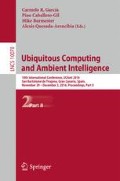Abstract
This paper addresses a practical and challenging problem concerning the recognition of behavioral symptoms dementia (BSD) such as aggressive and agitated behaviors. We propose two new algorithms for the recognition of these behaviors using two different sensors such as a Microsoft Kinect and an Accelerometer sensor. The first algorithm extracts skeleton based features from 3D joint positions data collected by a Kinect sensor, while the second algorithm extracts features from acceleration data collected by a Shimmer accelerometer sensor. Classification is then performed in both algorithms using ensemble learning classifier. We compared the performance of both algorithms in terms of recognition accuracy and processing time. The results obtained, through extensive experiments on a real dataset, showed better performance of the Accelerometer-based algorithm over the Kinect-based algorithm in terms of processing time, and less performance in terms of recognition accuracy. The results also showed how our algorithms outperformed several state of the art methods.
Access this chapter
Tax calculation will be finalised at checkout
Purchases are for personal use only
Notes
- 1.
- 2.
- 3.
Here we use the terms Behavior and Action interchangeably.
- 4.
References
Mihailidis, A., Boger, J., Craig, T., Hoey, J.: The coach prompting system to assist older adults with dementia through handwashing: an efficacy study. BMC Geriatr. 8(1), 28 (2008)
Desai, A., Grossberg, G.: Recognition and management of behavioral disturbances in dementia. Prim. Care Companion J. Clin. Psychiatry 3(3), 93 (2001)
Qiu, Q., Foo, S., Wai, A., Pham, V., Maniyeri, J., Biswas, J., Yap, P.: Multimodal information fusion for automated recognition of complex agitation behaviors of dementia patients. In: 2007 10th International Conference on Information Fusion, pp. 1–8. IEEE (2007)
Foo, S., Pham, V., Htwe, T., Qiu, Q., Wai, A., Maniyeri, J., Biswas, J., Yap, P.: Automated recognition of complex agitation behavior of demented patient using video camera. In: Conference One-Health Networking, Application and Services, pp. 68–73 (2007)
Wouter, V., Egon, V., Reinier, K., Schavemaker, J.: Towards sensing behavior using the kinect. In: 8th International Conference on Methods and Techniques in Behavioural Research, pp. 372–375. Noldus Information Technology (2012)
Banos, O., Calatroni, A., Damas, M., Pomares, H., Rojas, I., Sagha, H., Milln, J., Troster, G., Chavarriaga, R., Roggen, D.: Kinect=imu? learning mimo signal mappings to automatically translate activity recognition systems across sensor modalities. In: ISWC, pp. 92–99 (2012)
Nishkam, R., Nikhil, D., Preetham, M., Littman, M.: Activity recognition from accelerometer data. AAAI 5, 1541–1546 (2005)
Yun, X., Bachmann, E., Moore, H., Calusdian, J.: Self-contained position tracking of human movement using small inertial/magnetic sensor modules. In: IEEE International Conference on Robotics and Automation, pp. 2526–2533. IEEE (2007)
Xia, L., Chen, C., Aggarwal, J.: View invariant human action recognition using histograms of 3d joints. In: CVPR Workshops, pp. 20–27 (2012)
Chen, C., Jafari, R., Kehtarnavaz, N.: A survey of depth and inertial sensor fusion for human action recognition. Multimed. Tools Appl., 1–21 (2015)
Nirjon, S., Greenwood, C., Torres, C., Zhou, S., Stankovic, J., Yoon, H., Ra, H., Basaran, C., Park, T., Son, S. Kintense: a robust, accurate, real-time and evolving system for detecting aggressive actions from streaming 3d skeleton data. In: ACM Conference on Embedded Networked Sensor Systems, pp. 1–9 (2013)
Martinez, M., Stiefelhagen, R.: Automated multi-camera system for long term behavioral monitoring in intensive care units. In: Proceedings of the 13 IAPR International Conference on Machine Vision Applications, MVA, pp. 97–100 (2013)
Chase, J.G., Agogue, F., Starfinger, C., Lam, Z.H., Shaw, G.M., Rudge, A.D.: Quantifying agitation in sedated ICU patients using digital imaging. Comput. Method Prog. Biomed. 76, 131–141 (2004)
Biswas, J., Jayachandran, M., Thang, P., Fook, V., Choo, T., Qiang, Q., Takahashi, S., Jianzhong, E., Feng, C., Yap, P.: Agitation monitoring of persons with dementia based on acoustic sensors, pressure sensors, ultrasound sensors,: a feasibility study. In: International Conference on Aging, Disability and Independence, pp. 3–15 (2006)
Wenhui, L., Weihong, Z., Zhiwei, Z., Qiang, J.: A real-time human stress monitoring system using dynamic bayesian network. In: CVPR 2005, pp. 70–77 (2005)
Sakr, G., Elhajj, I., Huijer, H.: Support vector machines to define and detect agitation transition. IEEE Trans. Affect. Comput. 1(2), 98–108 (2010)
Pan, W., Yoshida, S., Liu, Q., Wu, C., Wang, J., Zhu, J., Cai, D.: Quantitative evaluation of severity of behavioral and psychological symptoms of dementia in patients with vascular dementia. Transl. Neurodegener. 2(9), 2–7 (2013)
Tractenberg, R., Singer, C., Cummings, J., Thal, L.: The sleep disorders inventory: an instrument for studies of sleep disturbance in persons with alzheimer’s disease. J. Sleep Res. 12(4), 331–337 (2003)
Knuff, A.: Application of actigraphy to the measurement of neuropsychiatric symptoms of agitation in dementia. Master’s thesis, Queen’s University, Canada (2014)
Zhu, Y., Wenbin, C., Guodong, G.: Fusing spatiotemporal features and joints for 3d action recognition. In: CVPRW, pp. 486–491 (2013)
Bao, L., Intille, S.S.: Activity recognition from user-annotated acceleration data. In: Ferscha, A., Mattern, F. (eds.) PERVASIVE 2004. LNCS, vol. 3001, pp. 1–17. Springer, Heidelberg (2004)
Stern, T.: Massachusetts General Hospital Handbook of General Hospital Psychiatry, 6th edn. Saunders, Elsevier, New York (2010)
Kwapisz, J., Weiss, G., Moore, S.: Activity recognition using cell phone accelerometers. SIGKDD Explor. Newsl. 12(2), 74–82 (2011)
Opitz, D., Maclin, R.: Popular ensemble methods: an empirical study. J. Artif. Intell. Res. 11, 169–198 (1999)
Rodriguez, J., Kuncheva, L., Alonso, C.: Rotation forest: a new classifier ensemble method. IEEE Trans. Pattern Analy. Mach. Intell. 28(10), 1619–1630 (2006)
Author information
Authors and Affiliations
Corresponding author
Editor information
Editors and Affiliations
Rights and permissions
Copyright information
© 2016 Springer International Publishing AG
About this paper
Cite this paper
Chikhaoui, B., Ye, B., Mihailidis, A. (2016). Ensemble Learning-Based Algorithms for Aggressive and Agitated Behavior Recognition. In: García, C., Caballero-Gil, P., Burmester, M., Quesada-Arencibia, A. (eds) Ubiquitous Computing and Ambient Intelligence. IWAAL AmIHEALTH UCAmI 2016 2016 2016. Lecture Notes in Computer Science(), vol 10070. Springer, Cham. https://doi.org/10.1007/978-3-319-48799-1_2
Download citation
DOI: https://doi.org/10.1007/978-3-319-48799-1_2
Published:
Publisher Name: Springer, Cham
Print ISBN: 978-3-319-48798-4
Online ISBN: 978-3-319-48799-1
eBook Packages: Computer ScienceComputer Science (R0)

